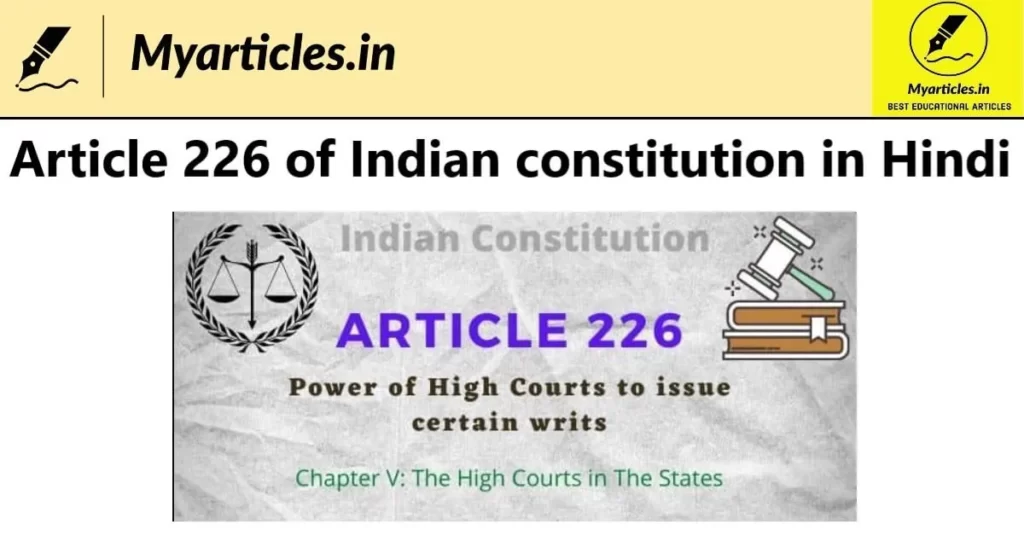Article 226 of Indian constitution in Hindi
Article 226 of the Constitution of India in Hindi is part of the Constitution’s “Chapter IV: Writ Jurisdiction,” which gives the High Courts of India the power to issue writs for the enforcement of Fundamental Rights and for any other purpose. The writs that can be issued under Article 226 include habeas corpus, mandamus, prohibition, quo warranto, and certiorari. These writs allow individuals to approach the High Courts to seek redress for violations of their rights and to challenge the actions of government officials and other public bodies.
Writ petition under article 226
The power of High Courts to issue certain writs, such as habeas corpus, mandamus, prohibition, and certiorari, is derived from Article 226 of the Indian Constitution. This article grants the power to the High Courts to issue writs for the enforcement of fundamental rights or for any other purpose.
These writs are considered to be powerful legal remedies that can be used to protect the rights of individuals and to challenge the actions of government authorities that are deemed to be illegal or unconstitutional. The writs can be issued against any person, including government officials and private individuals, for the enforcement of the fundamental rights guaranteed by the Constitution of India.
226 article in Hindi
अनुच्छेद 226: कुछ रिट जारी करने की उच्च न्यायालय की शक्ति
- 226(1): अनुच्छेद 32 में किसी बात के होते हुए भी प्रत्येक उच्च न्यायालय को उन राज्यक्षेत्रों में सर्वत्र, जिनके संबंध में वह अपनी अधिकारिता का प्रयोग करता है, नागरिकों को प्रदत्त अधिकारों में से किसी को प्रवर्तित कराने के लिए और किसी अन्य प्रयोजन के लिए उन राज्यक्षेत्रों के भीतर किसी व्यक्ति या प्राधिकारी को या समुचित मामलों में किसी सरकार को ऐसे निदेश, आदेश या रिट जिनके अंतर्गत बंदी प्रत्यक्षीकरण, परमादेश, प्रतिषेध, उत्प्रेषण और अधिकार-पृच्छा रिट हैं, या उनमें से कोई निकालने की शक्ति होगी।
- 226(2): किसी सरकार, प्राधिकारी या व्यक्ति को निदेश, आदेश या रिट निकालने की खंड (1) द्वारा प्रदत्त शक्ति का प्रयोग उन राज्यक्षेत्रों के संबंध में, जिनके भीतर ऐसी शक्ति के प्रयोग के लिए वादहेतुक पूर्णतः या भागतः उत्पन्न होता है, अधिकारिता का प्रयोग करने वाले किसी उच्च न्यायालय द्वारा भी, इस बात के होते हुए भी किया जा सकेगा कि ऐसी सरकार या प्राधिकारी का स्थान या ऐसे व्यक्ति का निवास स्थान उन राज्यक्षेत्रों के भीतर नहीं है।
- 226(3): जहां कोई पक्षकार, जिसके विरुद्ध खंड (1) के अधीन किसी याचिका पर या उससे संबंधित किसी कार्यवाही में व्यादेश के रूप में या रोक के रूप में या किसी अन्य रीति से कोई अंतरिम आदेश-
- (क) ऐसे पक्षकार को ऐसी याचिका की और ऐसे अंतरिम आदेश के लिए अभिवाक् के समर्थन में सभी दस्तावेजों की प्रतिलिपियां, और
- (ख) ऐसे पक्षकार को सुनवाई का अवसर,
- दिए बिना किया गया है, ऐसे आदेश को रद्द कराने के लिए उच्च न्यायालय को आवेदन करता है और ऐसे आवेदन की एक प्रतिलिपि उस पक्षकार को जिसके पक्ष में ऐसा आदेश किया गया है या उसके काउंसेल को देता है वहां उच्च न्यायालय उसकी प्राप्ति की तारीख से या ऐसे आवेदन की प्रतिलिपि इस प्रकार दिए जाने की तारीख से दो सप्ताह की अवधि के भीतर, इनमें से जो भी पश्चात्वर्ती हो, या जहां उच्च न्यायालय उस अवधि के अंतिम दिन बंद है वहां उसके ठीक बाद वाले दिन की समाप्ति से पहले जिस दिन उच्च न्यायालय खुला है, आवेदन को निपटाएगा और यदि आवेदन इस प्रकार नहीं निपटाया जाता है तो अंतरिम आदेश, यथास्थिति, उक्त अवधि की या उक्त ठीक बाद वाले दिन की समाप्ति पर रद्द हो जाएगा|
- 226(4): इस अनुच्छेद द्वारा उच्च न्यायालय को प्रदत्त शक्ति से,अनुच्छेद 32 के खंड (2) द्वारा उच्चतम न्यायालय को प्रदत्त शक्ति का अल्पीकरण नहीं होगा|

